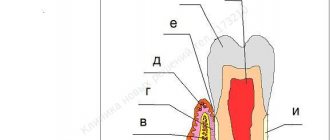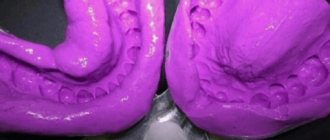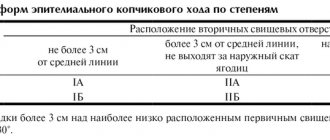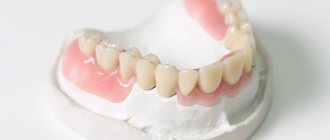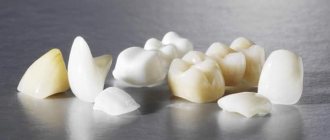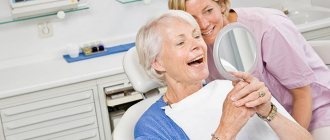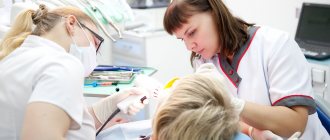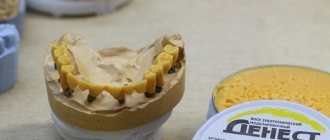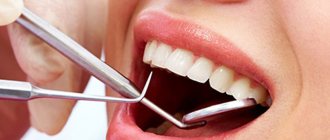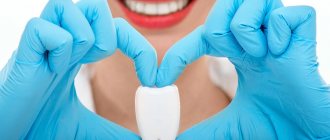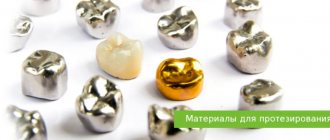Classification of impression materials
Among the many classifications of impression materials, the central position is occupied by the ISO classification, developed by G. Staegemann and R. Phillips in 1991. The classification is simple and is based on the consistency of the material after polymerization and the mechanism of the polymerization reaction itself.
| Hard | Elastic | |
| Irreversible; chemical curing | — Gypsum — Zinc-oxide-eugenol pastes | — Alginate hydrocolloids — Anhydrous elastomers:
|
| Reversible; Thermal curing | — Thermoplastic compounds | — Agar-agar hydrocolloids |
Rigid materials do not have elastic properties after curing and do not restore their original shape after deformation. Elastic materials tend to restore their original shape after exposure to elastic deformations. Elastic deformations are those within which the integrity of the material is maintained, that is, within the elastic modulus.
Some materials harden as a result of chemical reactions and in this case are irreversible, since the polymerization reaction is unidirectional and does not proceed in the opposite direction. Thermoplastic materials have the opposite property. Such materials at a temperature specific to each material acquire plastic properties and harden when cooled.
Gypsum
Medical plaster has found wide application both in dental work and in clinical practice. In dental laboratories, gypsum is consumed in tons per year. Despite such widespread use of gypsum, its use as an impression material is almost completely a thing of the past, and the very fact of its use often surprises young specialists. Gypsum was one of the first impression materials that made it possible to obtain impressions of satisfactory quality. However, in our time it is being replaced from practice by modern impression materials, which are significantly superior to gypsum in terms of quality characteristics. Therefore, many dentists are familiar with the expression V.N., which has already become popular in some circles. Kopeikina: “The use of gypsum as an impression material discredits the title of dentist.” But most dentists, if not themselves, then observed the process of taking impressions with plaster.
Calcium sulfate hemihydrate is used as an impression material, which is obtained by firing natural gypsum, which is calcium sulfate dihydrate. So, at a temperature of 110-130 ℃, calcium sulfate dihydrate decomposes to calcium sulfate hemihydrate, which is many times more soluble in water and precipitates in an aqueous solution in the form of the former calcium sulfate dihydrate.
| CaSO 4 2H 2 O → (CaSO 4 ) 2 H 2 O |
| 110-130℃ |
(CaSO 4 ) 2 H 2 O + 3H 2 O → CaSO 4 2H 2 O + t 0
The process of converting hemihydrate into dihydrate is an exothermic reaction, therefore, when making impressions with plaster, it was split and removed from the oral cavity before it completely hardened. In this way, overheating of the tissues is avoided and the plaster is easier to split.
However, gypsum continues to be used as an impression material. Gypsum has one important property that modern elastic materials cannot achieve - no shrinkage. This property is very valuable in the manufacture of cast structures, when the absence of deformation during removal from the oral cavity and subsequent shrinkage makes it possible to model and cast fixed dentures with excellent accuracy. Therefore, in some budgetary cases, for example, in the manufacture of cast structures in the lateral group of teeth, the use of gypsum may be acceptable and justified. There are also methods for taking impressions from implants using plaster. This allows you to avoid minute changes in the positions of transfers in the impression material. While human teeth have a certain degree of mobility and forgive minor deformations of the impression material, structures on implants have conditional immobility and the slightest changes in the position of the transfers relative to each other in the impression can cause unsatisfactory design of the prosthesis in the future.
| It is possible to remove plaster impressions from the oral cavity without breaking them only in the case of toothless jaws and in the absence of pronounced undercuts of the alveolar process |
What prostheses are made from impressions?
The basis of orthopedic structures are dental impressions. This material reflects the dentition and soft tissues of the oral cavity, on the basis of which dentures are made.
Impressions of teeth for prosthetics
are removed for the manufacture of the following structures:
- braces and trainers used in the treatment of malocclusion;
- dental crowns;
- bridges;
- removable and fixed prostheses;
- individual abutments.
Zinc oxide eugenol impression materials
Polymerization of zinc-oxide-eugenol (ZOE) both impression materials and dental cements occurs as a result of the interaction of eugenol and zinc oxide. Eugenol is characterized by an irritating effect on the human body, therefore the tube with zinc oxide contains mineral oils that eliminate this effect of the material. In addition to these additives, the composition of the tube with eugenol includes fillers such as talc, chalk, kaolin, which provide the necessary consistency of the material, add convenience during mixing, and help reduce shrinkage of the material during polymerization. Mineral salts and rosin accelerate the process of polymerization and hardening of the material.
Zinc-oxide-eugenol impression materials are highly accurate and are capable of reproducing relief elements measuring 50 microns. The material also has extremely low shrinkage, which is within 0.15%. However, the material is rigid and breaks when deformed when making an impression. Therefore, the material has a rather narrow scope of application, which is limited mainly to taking functional impressions from edentulous jaws, the alveolar process of which does not have pronounced undercuts and the material will not be deformed or distorted during removal. In addition, the material is used to register occlusion.
| Zinc oxide eugenol impression material Repin with a clove oil smell characteristic of the entire group of materials |
Thermoplastic compounds
The very name of thermoplastic compounds widely reveals the essence of these materials - it is a composition of substances that form a single mass, which, when heated, becomes plastic, can change its shape and hardens in this state when the temperature drops. And the fact that upon repeated heating this mass will again acquire the property of plasticity and determines its reversibility.
Classic thermoplastic compounds include rosin, talc, paraffin, ceresin, zinc oxide, as well as dyes and plasticizers to give the material the desired consistency at the plasticity stage.
The material is softened in a water bath at a temperature of 60-70 ℃, shaped and placed in an impression tray and applied to the tissue of the prosthetic bed, where it hardens at the temperature of the oral cavity. Therefore, the composition is selected in such a way that at a temperature of 37℃ the material completely hardens and does not deform during removal. However, the fact that the material does not deform is the main disadvantage that has limited the scope of application of thermoplastics. In addition, the material does not have the ability to accurately display terrain and does not maintain its spatial stability under environmental conditions.
Based on this, the material is used more as an auxiliary material for obtaining impressions, rather than as a main one, the role of which goes to more advanced materials. Thermoplastics can be used to record occlusion, which is also convenient because the material comes in sheet form. In addition, the material is convenient for the functional design of the edges of individual trays, which is an important condition for successful removable prosthetics.
| Release form of thermoplastic compounds | The material is softened in a water bath |
| Due to the low accuracy and final hardness, its scope of application is limited to registration of occlusion, functional design of impression edges and impressions of edentulous jaws | |
Elastic impression materials
The oral cavity has very thin and elegant shapes, smooth transitions give way to sharp angles, and, open to the eye, hides many secrets, and it is the impression materials that have the opportunity to demonstrate this to us. It is what is hidden, every natural narrowing, thin space between the teeth, the cervical and subgingival areas that are of greatest interest for successful prosthetics, which can be irretrievably lost due to irreversible deformations of the impression materials. This is the reason why elastic materials occupy the main place in the world of impression materials, almost completely displacing “hard” representatives, and offer their alternatives in full.
Agar impression materials
Agar impression materials are also called reversible hydrocolloid or simply agar hydrocolloid in comparison with the irreversible hydrocolloid alginate.
Agar-agar is a mixture of polysaccharides obtained from seaweed, which, when combined with water, forms the same hydrocolloid. Such a compound has a gel structure, formed as a result of a large number of hydrogen bonds, which are destroyed at a relatively low temperature, which is not capable of causing the destruction of the polymer. When heated, hydrogen bonds are destroyed and the gel turns into a sol, which is a viscous liquid convenient for use as an impression material. Upon subsequent cooling at the temperature of the oral cavity, the material again acquires a gel structure while maintaining the newly obtained spatial structure.
The material comes in various viscosities, packaged in tubes, and more fluid materials are available in syringes for convenient use in the gingival area.
Thermal transformations that are used when manipulating agar can burn the patient, so careful work is required and maintaining the optimal temperature of the material for the work and the patient. To do this, the material is first placed in a boiling water bath to quickly liquefy the materials. It is important not to overheat the material and not cause destruction of the polymer. Next, the material is transferred to a second water bath with a temperature of 60-70℃ to maintain the viscosity of the material. After this, the material is placed in a special impression tray with a water heating and cooling system, which is at a temperature that is not capable of causing a burn to the soft tissues of the oral cavity, but provides sufficient working time for the material.
Agar materials can be used in conditions of high humidity without distorting the impression, that is, in conditions of the gingival sulcus. The materials have high accuracy in displaying the relief and do not cause inconvenience when casting models. In addition, the materials taste good and do not leave permanent stains on clothes.
However, along with important positive qualities, the use of the material requires expensive equipment, such as special water-cooled trays, as well as a humidor for storing prints in high humidity conditions.
The material is not able to maintain its spatial stability for a long time, which makes it necessary to cast models no later than 15 minutes after taking impressions. But given that prints need time to recover from deformation, such requirements significantly reduce the quality of the print.
Along with this, low strength and low elastic memory can lead to irreversible deformations when removing impressions from the oral cavity.
The art of taking impressions
High-quality impressions form the basis for successful prosthetic restorations. However, the variety of materials and methods for obtaining them provokes confusion, which can negatively affect the success of dental treatment. In this article we will look at the impression as a unique form of art, analyze the characteristics of the most commonly used materials, indications for their use and techniques of use that allow us to achieve the proper quality of the negative image of the tissues of the prosthetic bed.
Despite the fact that scanners represent an excellent alternative to classic impressions, the latter continue to be frequently used in everyday dental practice. According to a recent survey, it was found that about 76% of dentists prefer to use a scanner rather than taking a physical impression, but only 48% of dentists actually use a scanner in all practical cases where there is a choice between one and a classic impression . In essence, an adequate impression is a detailed representation of the tissues of the oral cavity. It allows you to accurately copy the boundaries of the preparation and soft tissues, and the tooth stumps themselves in relation to other structures of the dentofacial apparatus. The quality of the impression directly affects the further accuracy of the fit of the orthopedic structure. However, obtaining them is sometimes complicated due to the gag reflex and the patient’s feeling of subjective discomfort. The correct choice of material and technique for obtaining an impression largely determines the ability to bypass all potential limitations during manipulation.
Evolution of impression materials
Impression materials were first introduced around the 1700s when Philipp Pfaff proposed the use of softened wax. Later, doctors began to use other materials. The main disadvantage of wax was that it became too distorted during removal from the mouth. Different types of gypsum and zinc-oxide-eugenol materials, on the contrary, were characterized by a deficiency of elastic properties. The development of hydrocolloid materials, agar and alginate (photo 1-2) has made it possible to obtain much greater precision with lower resistance to destruction.
Photo 1. Alginate impression.
Photo 2. Alginate impression material.
The only drawback was the loss of dimensional stability over a certain period of time. In order to improve the fracture resistance, a new type of material was introduced into practice - polysulfide, which, however, was also characterized by a decreasing pattern of dimensional stability. These materials were also quite difficult to mix and had a specific unpleasant odor. In the 1960s, the first attempt was made to bring polyesters to market, and in the 1970s, type A and C silicones were introduced. The chemical composition of these materials made it possible to almost completely solve the problem of dimensional stability and low tensile strength. But they are also imperfect, since there is still no material that would be suitable for absolutely all clinical situations. Dentists use impressions for one purpose - to obtain an exact replica of the hard and soft tissues of the prosthetic bed. Improved material properties make it possible to recreate a given replica with a higher level of accuracy.
Characteristics of impression materials
Hydrophilicity
Hydrophilicity, in essence, demonstrates the nature of the interaction of the impression with water, as well as how it reacts to its presence in the oral cavity. This characteristic significantly influences the final accuracy of the impression regarding the detailing of the structures of the prosthetic bed. Hydrophilic materials are characterized by a high “level of affinity” with moisture and provide a high level of tissue detail due to their high surface wetting properties. Hydrophobic materials, on the contrary, demonstrate a low level of interaction with moisture, therefore, they are characterized by poor wetting properties, which makes it difficult to achieve high detail. Hydroactive materials provide a combination of both hydrophobic and hydrophilic characteristics. They are hydrophobic in nature, but the addition of surfactants can increase their level of hydrophilicity. This type of hybrid materials has significantly improved capabilities for detailing the structures of the prosthetic bed, due to its unique surface wettability.
Elasticity and tensile strength
Elasticity and tensile strength demonstrate the nature of changes in the impression material when it is removed from the oral cavity. Ideally, the elasticity of a material should allow it to stretch and then return to its original shape. If the stretch of the print goes beyond the limits of its elasticity, then it is clear that it cannot return to its original shape. Similarly, tensile strength demonstrates the ability of a material to return to its original shape without tearing. The magnitude of this parameter is influenced by several factors, including gingival retraction, depth of the subgingival margin, intensity of bleeding, the presence of sharp edges on the surface of the prepared tooth, as well as preparation designs that increase the level of resistance when removing the impression from the oral cavity. Understanding these material characteristics is imperative to prevent the need for a repeat impression procedure. In addition, it is important to choose a material for work that can be properly disinfected, because the protocols for this procedure are also material-specific.
Viscosity
Viscosity characterizes the fluidity of a material that has not yet hardened. Viscosity classifications include low (eg, syringe-injected materials), medium (eg, single-stage monophasic or heavy body), high (eg, impression tray material), and very high (eg, putty-type material). Viscosity directly depends on the amount of filler in the structure of the material. In this case, viscosity directly affects the ability to fully detail the condition of the tissues of the prosthetic bed. Essentially speaking, the lower the viscosity of the material, the greater the chance of getting a detailed impression, but at the same time, the shrinkage of the material during its polymerization also increases significantly. It is much more difficult to work with low-viscosity materials than with high-viscosity materials. Depending on how accurate the doctor needs to achieve the impression, he can use different types of materials.
Working time and curing time
Working time and setting time characterize the amount of time required to mix the material and place it in the spoon, as well as the time required for the material to completely harden in the oral cavity. Working time depends on the number of material components used, the use of manual or automatic mixing methods and the viscosity of the material. Manufacturers provide the clinician with a huge selection of impression materials with different working time characteristics. The temperature parameter affects both the working time and the curing time. We should also not forget that the working time of the material also depends on the direct recommendations of the manufacturer, and on the manipulation skills of the assistant or the dentist himself.
Dimensional stability
Dimensional stability is a parameter that directly affects whether the dental laboratory receives accurate and stable impressions, or whether the structure of such impressions does change during short-term storage. Ideally, the resulting impression can be stored for a sufficiently long period of time without affecting the ability to obtain several plaster models from it. The dimensional stability indicator depends on the influence of temperature, moisture absorption and the level of reduction in spatial volume as a result of polymerization.
Material selection
Preprints
Preliminary impressions are not characterized by the need for high detail of the tissues of the prosthetic bed; therefore, less expensive materials such as hydrocolloids, alginates or polysulfates can be used to obtain them. However, the use of these materials should be avoided when obtaining final impressions. Firstly, hydrocolloids are 80% water. They are extremely delicate and have low tensile strength. Polysulfates, in turn, are characterized by low dimensional stability, which, however, is sufficient for treatment planning. It is important to understand that although preliminary impressions do not involve super-details, they must be accurate enough for further planning of a complex of dental procedures. Typically, these impressions are used to analyze occlusion, the shape of the dental arch, the occlusal plane, and aesthetic relationships. Polyvinylsiloxane materials are ideal for obtaining optimal diagnostic impressions. They are characterized by fairly high dimensional stability, therefore, eliminating the need for immediate casting of the model. Before taking an impression, you should thoroughly dry your teeth and be sure that there is enough material to record all surfaces of the teeth, including the area behind the free gingival margin (photo 3-4).
Photo 3. View of the full print.
Photo 4. Impression of a quadrant of the jaw.
Final prints
Polyesters are the optimal material of choice for final prints. They are hydrophilic, characterized by long dimensional stability and short curing time. In addition, the level of deformation of polyesters during removal from the oral cavity is minimal, and the tensile strength is sufficient to eliminate the possibility of permanent deformation. The disadvantage of polyesters is their rigidity, unpleasant taste and smell, and the ability to absorb moisture from the atmosphere and swell over time. In addition, polyester impressions are quite difficult to remove from the oral cavity. Vinyl siloxanes remain another optimal choice for final print materials. The latter are less harsh than ethers, have a neutral taste and odor, and do not absorb excessive amounts of moisture. Vinylsiloxane prints can be used to produce multiple models at once and have high accuracy, excellent elasticity, improved dimensional stability and sufficient tensile strength. The hydrophilicity of polyvinylsiloxanes is increased by adding surfactants to their structure. The disadvantage of these materials is a decrease in the polymerization pattern in the presence of latex contamination. There are also hybrid materials that combine polyvinylsiloxanes and polyesters - vinyl-polyesters. Hybrid materials are characterized by high tensile strength and increased dimensional stability parameters. The polyester component of the hybrids ensures their hydrophilic nature without the need to add surfactants, and the silicone component increases dimensional stability and elasticity parameters. Like some silicones, hybrid materials have a pleasant taste and odor, unlike polyesters (photo 5).
Photo 5. Full impression made using polyvinylsiloxane.
Impression technique
Photos 6-7 show a step-by-step protocol for obtaining impressions. Methods for obtaining impressions using the retraction technique are described below.
Photo 6. Algorithm for obtaining impressions from the upper jaw.
Photo 7. Algorithm for obtaining impressions from the lower jaw.
Retraction methods
It is important to recognize that retraction and hemostasis essentially have two different goals. Of course, sometimes both of them can be achieved through the same manipulation. Retraction is the temporary movement of gum tissue away from the surface of the tooth to expose the subgingival margin and create a space into which the impression material must be placed. Retraction can be carried out even before tooth preparation begins. In this case, it allows better visualization of the preparation margin area, which minimizes the risk of iatrogenic damage to the gums in the cervical area, and thus does not compromise the level of periodontal support of the tooth. There are four main retraction methods available today. The choice among them should be based on the doctor’s familiarity with the technique, localization, quality and condition of the soft tissues, as well as the complexity of the clinical situation as a whole.
Thread technique
The retraction suture packing technique is one of the most popular retraction methods, which is performed using twisted, knitted, woven or braided suture. To make them, different types of fibers are used, including wool, cotton and silk. These threads are available in two versions: impregnated with a hemostatic agent or not impregnated. When packing filament, it is important to understand the required size. Ideally, it is best to use the smallest suture size possible, as this will minimize the risk of gum injury, bleeding, or rupture of the sulcular epithelium. Typically, the sutures are packaged after preparation and removed immediately before the impression is taken.
Single thread technique. The technique of packing one retraction cord allows you to “push back” the soft tissue and create the necessary space in the area of the supragingival edge of the preparation. Although this manipulation is somewhat uncomfortable, it allows one to visualize the required boundary of enamel and dentin reduction, as well as to recreate the conditions for penetration of the impression material into this area. Typically, the packaged filament remains in the groove until the impression begins. The tip of the packer (the instrument used to pack the thread) must be thin enough so as not to damage surrounding tissue or cause bleeding (photo 8). The correct inclination of the packer working head allows you to optimize the thread packing procedure.
Photo 8. Packaging of retraction thread.
Two thread technique. This approach is similar to that described above, but another one is packaged on top of the initially installed thread. In this way, it is possible to achieve greater retraction of the mucosa and recreate the required volume of free space. Packing two threads at once allows you to create conditions for detailing the area of the gingival margin. However, when performing this procedure, the patient may complain of a certain feeling of discomfort.
Gum retraction technique using paste
The paste gum retraction technique is designed to minimize pain and discomfort during the procedure. When placed in the sulcus, the paste provides soft tissue displacement, thereby increasing the visualization of the preparation margin (Figure 9). The chemical composition of the paste also provides a hemostasis function, and this method can be used as an alternative to single suture retraction.
Photo 9. Retraction using paste.
Treatment of soft tissues using laser
Using a laser, surgical retraction of soft tissue can be achieved. This approach is safer than using a device for electrosurgical interventions, since the active agent is high-intensity radiation instead of electric current. Delivery of the laser beam to the intervention area is ensured using thin glass fiber or optical fiber (photo 10). Lasers cause shallow cellular necrotic burns in tissue adjacent to the epithelial layer, so healing is faster and more predictable. Although lasers can also cause burns to dentin, cementum, and attached soft tissue, the risk of such burns is minimal. The laser can also be used completely safely for patients with pacemakers, or in cases of concurrent general anesthesia with a mixture of gases. Depending on the type and wavelength of the laser, they may or may not be helpful in assisting hemostasis. The use of lasers is especially recommended in cases where the gingival margin is too deep, or when there is heavy bleeding in the intervention area.
Photo 10. Treatment of soft tissues using a laser.
conclusions
An ideal impression allows you to accurately copy all the structural features of the tissues of the prosthetic bed, while ensuring proper dimensional stability and the possibility of further obtaining several plaster models from it at once. Over the past 250 years, improvements in dental technology have enabled dental professionals to obtain highly accurate impressions through fairly simple manipulative approaches without compromising patient comfort during such procedures. The success of taking an impression depends on a careful evaluation of the original clinical restoration, the type of restoration planned, and the technique the clinician plans to use to accurately record the condition of the tissues of the prosthetic bed.
Author: Shannon Pace Brinker, CDA, CDD
Alginate impression materials
Alginate impression materials have taken a very strong position in the clinic of orthopedic dentistry, in particular in removable prosthetics, as well as in the manufacture of orthodontic appliances. The fact is that it is alginate materials, despite their shortcomings, that are capable of imaging the soft tissues of the oral cavity over a large area. It is alginates that are able to fully display the transitional fold, frenulum and other natural folds and relief of the mucosa, which is extremely important in the manufacture of prostheses or devices that are in direct contact with the oral mucosa over a large area. Such prostheses include complete and partial plate dentures and clasp dentures, as well as various orthodontic appliances. In addition, removable prosthetics in orthopedic dentistry are often low-cost prosthetics, often for older people, and given the low cost of alginate impression materials, their use has a beneficial effect on patient comfort
Alginate impression material is available in powder form, packaged in bags or jars. The powder consists of sodium and potassium salts of alginic acid, which is obtained from seaweed, mainly Laminaria, and calcium salts, most often calcium sulfate, which when mixed with water form an irreversible gel. The gel remains a gel until the water in its composition evaporates and turns the material into a hard and brittle mass. To preserve water in the mass for a long time, the powder also contains inhibitors, which are some sodium and potassium salts. To give the material the required consistency, talc, zinc oxide and other fillers are also added to the powder.
The material is mixed with a metal or plastic spatula in a rubber flask. Using special measuring cups, pour the required amount of powder into the flask, and then add the appropriate amount of water and mix thoroughly. The flask is placed sideways on the palm of your hand and the powder and water are “rubbed” into the wall using figure-of-eight movements. Correct execution of this manipulation will ensure a homogeneous consistency of the material, since even experienced dentists cannot always mix the material uniformly and without lumps, which will directly affect the quality of the impression and the model cast on it. To facilitate the doctor’s work, there are special systems for automatically mixing the material, but again, alginate impression materials are often used for budget prosthetics and such systems are not always justified.
Also, the curing time of alginates is quite sensitive to water temperature. Water at room temperature is considered optimal, that is, approximately 22℃, at which the material will harden in 3-4 minutes, and changing the temperature by one degree up or down can speed up or slow down the gelling time by about 20 seconds, respectively.
Impressions obtained with alginate impression materials are quite accurate, which is determined by the reproduction of relief details measuring 50 microns. Such impressions recover well after deformation and are easily separated from the model material.
But in the process of further reactions occurring in the material after removal from the oral cavity, reaction by-products are released, such as water, acids, and other particles, which affect the hardening process of gypsum and its surface structure, which does not allow obtaining a smooth surface of plaster models . This property sharply limits the scope of application of the material and does not allow the material to be used in the manufacture of fixed prosthetic structures.
However, the most important feature of alginate impression materials is, unfortunately, their negative property - spatial instability. Alginates are very sensitive to dryness or, conversely, humidity. When storing the print both in open conditions and in water, shrinkage and swelling respectively exceed the maximum permissible value of 0.3%. This requires casting models within 15 minutes after the impression is removed from the oral cavity, which also affects its recovery after deformation and the quality of the resulting model. Therefore, if there is a possible longer delay before receiving the models, the print must be placed in a sealed bag, within which changes in the dimensions of the material will be within acceptable limits.
| Ypeen and Hydrogum materials are the most popular alginate impression materials |
How much does dental prosthetics cost?
Taking impressions is a mandatory procedure before prosthetics, without which it is impossible to create orthopedic structures for installation. As a rule, this procedure is included in the total cost of prosthetics.
How much does it cost to get dentures?
, depends on various nuances: the type of orthopedic structure chosen for installation, the material for the impression, the complexity of the case and the individual tariffs of the dental center.
We have established affordable prices for prosthetics and dental implants. Medical and surgical procedures are performed by qualified dentists with extensive professional experience, using innovative techniques and high-quality materials from the world's best manufacturers.
How much does dental prosthetics cost:
- removable
dentures – from RUB 17,400; - dental crowns – from RUB 3,300;
- veneers – from 12,000 rubles;
- tabs – from 6500 rub.
More detailed information about prices and services of the center is available on the official website. All patients who leave their reviews on our website are guaranteed to receive a 3% discount on all types of dental services (this is additional and is added to the main discounts available to the client).
Elastomeric impression materials
Materials from the group of elastomeric impression materials are among the most progressive among all materials, and the fact that manufacturing companies direct their main efforts specifically to improving this group of impression materials is both an indicator of the high class of materials, and a consequence of this, to achieve maximum results and competition in the industry. advanced levels.
The group of elastic materials consists of four more types of materials:
- Polysulfide impression materials;
- Silicone impression materials of condensed type (C-type);
- Silicone impression materials of connecting type (A-type);
- Polyester impression materials.
This separation of materials is based on the difference in chemical composition and polymerization reactions.
In addition, elastomeric impression materials are divided into degrees of viscosity:
- Type 0 – very high viscosity ( Putty );
- Type 1 – high viscosity ( H igh);
- Type 2 – medium viscosity ( M edium);
- Type 3 – low viscosity ( L ow).
Separation of materials by viscosity helps to obtain both highly accurate and durable impressions, thanks to two-phase impression techniques and the use of individual trays.
Polysulfide impression materials
When lead dioxide is added to the polysulfide polymer, which is the main component of polysulfide impression materials, the reaction of further polymerization and hardening of the material is initiated. This process is called vulcanization.
Polysulfide impression materials have extremely high elasticity and, as a result, high tensile strength, which on the one hand makes it possible to obtain impressions of very high quality, however, due to such final elasticity and insufficient hardness, the degree of deformation of the material and models, despite high accuracy, are not able to display the real picture of the relief of the tissues of the prosthetic bed.
In addition, the materials are hydrophobic, which requires keeping the tissues of the prosthetic bed dry. The materials are not characterized by long-term spatial stability, which requires obtaining models as soon as possible after taking the impression, which adversely affects the degree of recovery of the material after deformation, which is especially important for the group of elastomeric impression materials.
Condensed type silicone impression materials (C-type)
The polymerization reaction of condensed silicone impression materials is based on the interaction of dimethylsiloxane with acrylic silicates, releasing a reaction by-product in the form of ethyl alcohol.
The form of release of the material depends on the degree of viscosity of the material: base pastes of materials of 0 and 1 viscosity types are produced in cans, materials of 2 and 3 types are packaged in tubes, and the catalyst in tubes is common for all types of viscosity from one manufacturer. Unlike silicone impression materials of the attachment type, C-type materials are not produced in forms for automatic mixing, since from a marketing and financial point of view this is unprofitable and unreasonable due to the fact that A-type materials are more advanced and much more expensive, while While C-silicones are used in more budget-friendly work, the extra costs for automatic mixing will be inappropriate.
C-type silicones have high tensile strength and sufficient hardness, which has a positive effect on the display of small and important relief details, such as the preparation boundary. A high degree of recovery after deformation, versatility and low price determine the widespread use of materials in the clinic of fixed prosthetics.
However, the materials are hydrophobic and high-quality impressions made from such materials require keeping the tissues of the prosthetic bed dry. A significant drawback is the spatial instability caused by the release of a by-product of the polymerization reaction (ethyl alcohol) and shrinkage, which in a short time exceeds the permissible values and requires rapid casting of models, which directly affects their reliability due to the insufficient degree of restoration of the impression after deformation.
| Zetaplus - C-type base silicone material and Oranwash C-type corrective silicone have a common catalyst - Indurent gel |
Polyester impression materials
The basis of polyester materials is the polyester polymer on the base paste side and the alkyl contained in the catalyst paste and initiating the polymerization reaction.
Polyester impression materials have high dimensional stability, and the stiffness of the material increases over time, making them more suitable for taking impressions of implants. In addition, a long working time, which is then replaced by a sharp hardening, is again convenient for taking impressions from implants, since some manipulations with implants are long and the long-term viscosity of the material contributes to quiet work without fear of premature hardening of the material, which occurs relatively abruptly, which is again convenient for the doctor and the patient.
Long-term storage of material without changing the spatial structure allows one to obtain delayed models and fully use the property of elastic memory.
Also, polyesters have thixotropy, which makes them more fluid under pressure and allows you to display small relief elements. Sufficiently high hydrophilicity forgives moisture in the tissues of the prosthetic bed without reducing the quality of the impression.
High-rigidity materials are quite hard after hardening, which can cause fractures of weakened teeth or dislocations due to periodontal diseases. To avoid such complications, it is important to isolate severe undercuts using low-viscosity materials.
However, all these advantages of polyester impression materials come at a price, which results in the high cost of such materials.
| Impregum material in tubes for automatic mixing in the Pentamix apparatus | Pentamix 3 device for automatic mixing of impression materials |
Silicone impression materials of connecting type (A-type)
Along with polyesters, silicone materials of the connecting type are among the most advanced impression materials, which is the reason for their increasingly widespread use in clinical practice and the desire to almost completely replace other materials in the clinic of modern dentistry.
Unlike C-silicones, the polymerization reaction of addition-type silicone is not accompanied by the release of reaction by-products, which avoids the main disadvantage of the first - shrinkage, which goes beyond acceptable limits in a relatively short time. The high class of the material also determines its high cost, which is justified by the high quality of the print and the final design as a whole.
The impression material has a high accuracy of relief display, good wettability and elasticity, which is maintained by the necessary hardness when using techniques for obtaining two-phase impressions. Pleasant color, taste and smell are convenient, first of all, for the patient, and the introduction of automatic mixing systems brings convenience to the doctor. In addition to the standard form of release in plastic jars and tubes, together with polyesters, A-silicones are produced in special cartridges for automatic mixing using special devices for materials of viscosity types 0 and 1 and dispensers for viscosity types 2 and 3, which is convenient for accurately applying impression material to the gingival tissue area and border of preparation.
However, some materials in this group are hydrophobic, which requires ensuring the field is dry. When mixing the material, you cannot use latex gloves, which is dictated by the property of latex to inhibit the polymerization reaction of such a material.
| Elite HD+ A-type silicone base material for manual mixing | Corrective silicone material A-type Elite HD+ for automatic mixing |
| The automatic mixing dispenser forces material from specially designed tubes into the mixing tip |
The article was written by N.A. Sokolov. especially for the OHI-S.COM website. Please, when copying material, do not forget to provide a link to the current page.
